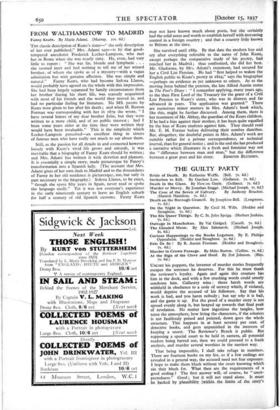FROM WALTHAMSTOW TO MADRID
Fanny Keats. By Marie Adami. (Murray. ros. 6d.)
THE classic description of Keats's sister-" the only description of her ever published," Mrs. Adami says-is by that good- tempered anecdotist Frederick Locker-Lampson, who met her in Rome when she was nearly sixty. He, even, had very little to report : "She was fat, blonde and lymphatic . . . she seemed inert and had nothing to tell me of her wizard brother, of whom she spoke as of a mystery-with a vague admiration but with genuine affection. She was simple and natural." Fanny Keats, who had become Sefora Llanos, would probably have agreed on the whole with this impression. She had been largely separated by family circumstances from her brother -during his short life, was scarcely acquainted with most of his friends and the world they moved in, and had no particular feeling for literature. No MS. poems by Keats were given to her after his death ; and when H. Buxton Forman was corresponding with her in 1879 she wrote, "I have several letters of my dear brother John, but they were written to a mere child, and of no public interest ; had I been some years older at the time they were written they would have been invaluable." This is the simplicity which Locker-Lampson perceived-an excellent thing in sisters of famous men who have really not much to say about them.
Still, as the passion for all details in and connected however loosely with Keats's vivid life grows and extends, it was inevitable that a biography of Fanny Keats should be written; and Mrs. Adami has written it with devotion and pleasure. It is essentially a simple story, made picturesque by Fanny's transformation into a Spanish lady. (The account that Mrs. Adami gives of her own dash to Madrid and to the descendants of Fanny in her old residence is picturesque, too, but only in part necessary to the biography.) Senora Llanos, to be exact, "though she spent fifty years in Spain, never read or spoke the language easily." Yet it was not everyone's experience in the early nineteenth century to leave an English suburb for half a century of old Spanish customs. Fanny Keats
may not have known much about poets, but she certainly had the solid sense and worth to establish herself with increasing control in a foreign country ; and that a country little known to Britons at the time.
She survived until 1889. By that date the modern hue and cry after everything referable to the name of John Keats, except perhaps the comparative study of his poetry, had reached her in Madrid ; thus confronted, she did her best. Mr. Gladstone, by Mrs. Adami's statement, had secured for her a Civil List Pension. He had "first helped to waken the English public to Keats's poetry in 1829," says the biographer -perhaps on evidence as yet unknown to others. As to the moving force behind the pension, the late Alfred Austin states in The Poet's Diary : "I remember applying, many years ago, to the then First Lord of the Treasury for the grant of a Civil List Pension to Keats's sister, who was in distress and far advanced in years. The application was granted." There are numerous minor matters in Mrs. Adami's book which, like this, might be further discussed. Among them, there is her treatment of Mr. Abbey, the guardian of the Keats children. If he had a bias against their mother, it has been quite equalled by the bias of Keats students against him. They should read Mr. E. M. Forster before delivering their sombre diatribes. But, altogether, the doubtful points in Mrs. Adami's work are suitable rather for a private correspondence, or technical journal, than for general notice ; and in the end she has produced a narrative which illustrates in a fresh and feminine way not the "difference between man and man," but the difference between a great poet and his sister. EDMUND BLUNDEN.






















































 Previous page
Previous page